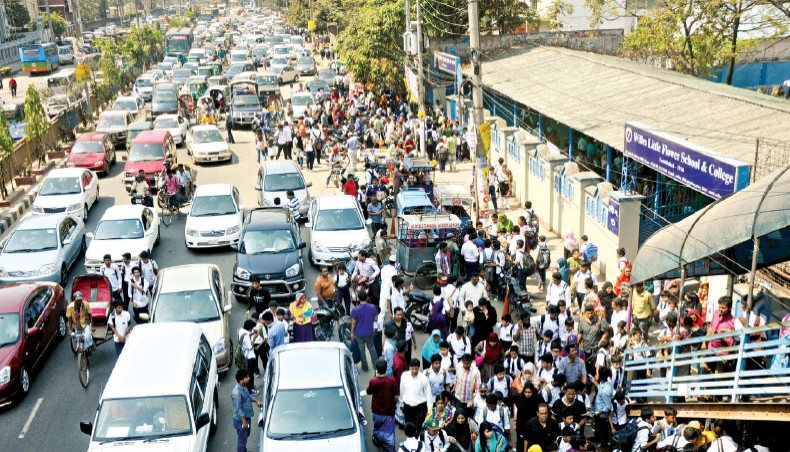
Students find it difficult to move due to severe traffic congestion in front of Willes Little Flower School at Kakrail in Dhaka after school hours. The photo was taken recently.
Concentration of schools and coaching centres at select residential areas of the capital causes serious traffic jams.
Wayside schools and coaching centres also create problems for smooth traffic movement at different areas of the capital.
As no permission from Rajdhani Unnayan Kartripakkha and Dhaka Transport Coordinating Authority is required schools and coaching centres are opened also at busy intersections.
The use of private cars and rickshaws for bringing students to schools and coaching centres and keeping them parked before them clog the roads at school hours.
Additional police deployments provided no results in areas having clusters of schools, Dhaka Metropolitan police’s additional commissioner for traffic management Mosleh Uddin Ahmed, told New Age.
It gets difficult to manage traffic movement near schools, he said, as they were opened without following plans.
Most of the schools in the capital and elsewhere in the country were opened at rented accommodations without taking Rajuk’s permission, said Rajuk member for development control Md Asmaul Hossain.
Before opening, educational institutions, stadiums, markets and business establishments must take permission from Rajuk and DTCA as they generate traffic, said BUET civil engineering professor and communication expert Md Shamsul Hoque.
Schools generate ‘undisciplined trips’ as students are brought from various areas on private cars and rickshaws said Shamsul Hoque relying on his private study on the issue.
Coaching centres intensify daylong traffic mess, he said.
The education ministry is silent about the need of taking permission from Rajuk or DTCA in its registration policy for English medium schools.
Education ministry’s policy on non-government school don’t require them to take Rajuk’s and DTCA’s permission before they are opened.
There is no enforcement of the two policies which prohibit opening more than one school within one km.
Dhaka education board’s inspector of schools ATM Moinul Hossain said that the policies were not enforced considering the future of students.
He could not explain why seven schools and several kindergartens could be opened within one km of Agrani Gils School at Azimpur.
The schools in question include Viqarunnesa Noon School, Azimpur School,
BUET Laboratory School, Udayan School, University Laboratory School besides a host of kindergartens.
The area’s residents said serious traffic jams hinder their movements every day.
Residents of Shahjahanpur, Motijheel, Siddheswari, Dhanmondi, Asad Gate, Uttara and other areas in the capital hosting schools and coaching centres made similar complaints.
Dhanmondi faces traffic congestions from its 50 schools including 35 English Medium ones.
Traffic congestions caused by schools at Dhanmondi Residential Area also create problems in all the nearby localities.
Uttara’s over 50 schools also create similar traffic issues.
English medium schools grew up at Dhanmondi and Uttara following the law of demand and supply, said Bangladesh English Medium School Association’s general secretary GM Nizam Uddin.
Residents said schools and shopping centres changed the character of both the posh residential areas.
Following a writ petition the High Court Division in 2012 ordered Rjuk to remove schools and commercial establishments from Dhanmondi Residential Area within three years.
The High Court Division in a separate directive asked Maple Leaf International School authorities to shift their schools from Dhanmondi within three years and manage traffic during school hours with their own manpower.
In August, the Appellate Division rejected Maple Leaf’s Appeal against the HC order.
BUET urban and regional planning professor Mohammad Shakil Akther said reserving enrolments for students in each school locality alone could end the capital’s growing traffic jams.
He said that many developed countries tackled school hour traffic jams by reserving enrolments for school catchment areas.
Education minister Nurul Islam Nahid said that he was aware about the issues.
He also said that the government was establishing new schools at different corners of the capital to end the rush of students to select schools.
New education law on enactment would discourage opening schools anywhere and everywhere, said Nahid.
– See more at: http://www.newagebd.net/article/2107/schools-at-residential-areas-street-intersections-blamed#sthash.JyunYK6n.dpuf
Source: New Age

